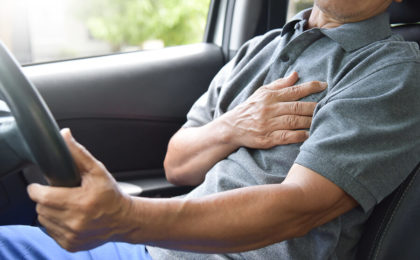Chest injuries are devastating. Car crashes are the most common cause of blunt trauma to the chest. In one recent year, 131,390 car accidents took place in Missouri, with 47,894 people injured. Seat belts or airbags can cause chest injuries in car accidents. If the vehicle occupant is not wearing a seat belt, they may hit the steering wheel or dashboard. Trauma to the chest has a high mortality rate, up to 60 percent depending on the nature of the injury.
If you or a loved one suffered a chest injury due to another’s negligence, you likely face high medical bills, lost income, and other consequences. A St. Louis chest injury lawyer can help you understand the process of recovering financial compensation for your harm.
Chest injuries and trauma

The chest is the part of your body between your head and your abdomen, which doctors call your thorax. The thoracic cavity is the interior of the chest. Your ribs protect the thoracic cavity, which protects your heart, lungs, several major blood vessels, and many large muscle groups.
Because the chest contains so many vital organs, blood vessels, and other essential body parts, chest trauma may result in a wide variety of serious injuries, including:
- Fractured ribs
- Pulmonary or lung injuries
- Chest wall contusion
- Chest wall hematoma
- Cardiac injuries
- Airway injury
- Injury to blood vessels.
How do chest injuries occur?

Typically, chest injuries fall into three basic categories:
Blunt force chest injuries
Blunt chest trauma is a sudden, forceful blow or impact to the chest. It happens when an object hits the chest without breaking the skin—for example, a heavy object dropped on the chest at work or a baseball that strikes a player in the chest.
Penetrating chest injuries
A penetrating chest injury occurs when an object punctures the skin of your chest. It may damage tissues or organs, leaving an open wound. The severity of the internal injury depends on the organ(s) penetrated and on how vital the organ is. Gunshot wounds and stabbing are the most common causes of penetrating trauma.
Blast chest injuries
Explosions cause pressure waves that can squeeze your lungs, causing tiny air sacs in your lungs to rupture. This injury leads to a condition called pulmonary barotrauma. These injuries are commonly associated with combat or attacks. However, they may also occur during workplace accidents or motor vehicle crashes that involve an explosion.
Diagnosis of chest trauma injuries
If the injured person can talk, the doctor will question them regarding the location and severity of the pain. The doctor usually diagnoses chest injuries through physical examination, X-rays, EKG, and CT scans. The doctor may order contrast dye so that they can see the arteries and veins on the X-ray. This helps the doctor identify internal bleeding and damage to the heart and major blood vessels. The doctor may also order an MRI to diagnose soft tissue injuries.
Common chest injuries from accidents
Blunt force trauma and penetrating chest trauma often produce very different injuries. For example, blunt injuries sustained in an auto accident often damage the chest wall, ribs, muscles, ligaments, and tendons. However, penetrating chest trauma, such as a gunshot or flying glass, has a greater chance of damaging body parts such as the heart, lungs, esophagus, and aorta.
Types of chest injuries include:
- Heart injury - A penetrating or blunt trauma to the heart may bruise the heart muscle, tear the heart’s walls, or damage a heart valve. Heart injuries are usually the result of a car crash but can happen due to falls and other accidents.
- Collapsed lung - A collapsed lung occurs when air gets inside the chest cavity (outside the lung) and creates pressure against the lung. Also known as pneumothorax, collapsed lung causes pain and difficulty breathing. Blunt force or penetrating trauma may cause a collapsed lung. The medical term for a partially collapsed lung is atelectasis, while a total collapsed lung is a pneumothorax. An individual with a collapsed lung should seek medical care immediately.
- Organ damage - The ribcage and chest protect several vital organs, including the stomach, spleen, intestines, kidneys, and liver. A blunt or penetrating trauma during an accident can injure many organs crucial to your body’s functioning.
- Broken ribs - Chest trauma can cause bruised or broken ribs or cartilage fracture. The pain of a broken rib usually worsens when you press on the injured area, twist your body, or breathe deeply. In some cases, multiple rib fractures can lead to pneumonia.
- Flail chest - Flail chest results from blunt trauma to the chest. If the injured person has multiple fractures in three or more ribs in a row, it can cause a part of the rib cage to break and detach from the chest wall. It usually involves an underlying lung injury and is life-threatening if not treated promptly.
- Diaphragm injury - The diaphragm is the dome-shaped muscle that separates the thorax (chest) from the abdomen. It helps you breathe. Penetrating or blunt trauma can cause the diaphragm to tear, which may lead to herniated organs in the abdominal area. A diaphragm injury is particularly common in cases of penetrating trauma.
Symptoms of chest injuries
The injured person should be aware that they may have suffered a severe injury, even if the injury is not visible.
Symptoms of chest injuries may include, but are not limited to:
- Chest pain that becomes more intense when coughing, sneezing, or laughing
- Abdominal pain
- Difficulty breathing
- Crunching sounds in the ribs
- Sensitive or painful to touch
- Coughing up blood
- Weakness or dizziness
- Bruising
- Nausea or vomiting
- One segment of the chest wall may not move with breathing or move opposite to the rest of the chest wall (flail chest)
The cause of chest pain is difficult to diagnose from symptoms alone. For this reason, it is vital to contact a doctor immediately for this complaint.
What are the complications of chest injury?
Although there is a wide range of complications following any injury, a chest infection is the most common complication following a chest injury. Other complications include blood or air in the space surrounding the lung, air trapped under the skin in the chest wall, abdominal injuries, respiratory failure, pneumonia, and pleural sepsis may also occur. The severity of the injury and the patient's physical condition affects the likelihood of complications.
Treatment of chest injuries

The treatment of chest injuries varies according to the nature and severity of the injury. Treatment usually begins at the scene of the accident. Emergency medical personnel stabilize the patient before transporting them to an emergency room or trauma center for further treatment.
In some cases, emergency medical personnel recommend that:
- No one removes an object that penetrated the chest cavity and is still there.
- The medical professional should quickly apply an airtight dressing to cover any hole in the chest cavity.
- The EMT should immobilize the injured person’s neck and back after a possible chest injury.
- If possible, position the injured person with the injured side down.
- The EMT should provide the injured person with pure oxygen to breathe.
- Medical personnel should perform CPR if necessary.
Upon arrival at the emergency room, the healthcare professional may prescribe medication to treat the causes of chest pain. Depending on the circumstances, the doctor may perform surgical or other procedures. For example, if the injured person has a collapsed lung, the doctor may insert a tube in the chest to reinflate the lung.
Doctors generally treat rib fractures immediately because broken ribs may cause punctured lungs or blood vessel damage, which may be fatal. The doctor may also order anesthesia for the nerves that supply the lungs, which lessens the pain and the chance of pneumonia.
In some cases, fluid builds up in the pericardium (the sac around the heart), resulting in heart compression. This complication may happen quickly or gradually after the injury. Blood fills the chest area preventing the heart from expanding normally as it pumps. The doctor may insert a needle into the chest cavity to draw out the excess blood and relieve the pressure on the heart to maintain proper circulation.
Personal injury claims
Most personal injury claims originate in the theory of negligence: “A failure to behave with the level of care that someone of ordinary prudence would have exercised under the same circumstances.”
To establish negligence, the plaintiff must prove that the defendant owed a duty to the plaintiff; the defendant breached that duty; the plaintiff suffered an injury; and the defendant’s breach of duty caused the injury.
Sometimes strict liability is the basis for the claim. In these cases, the injured person does not have to establish negligence. This theory helps in cases involving defectively manufactured products. The plaintiff only needs to show that those who created the product designed or manufactured it in a manner that made it unreasonably dangerous when used as intended. In other circumstances, intentional wrongs can also be the basis for personal injury claims.
The two key issues in every personal injury claim are liability and damages. What kind of damages did the injured person incur, and who was responsible for the injury? These issues are the basis for an award of compensation.
There may be one person or entity responsible for your injury.
For example, in a car crash, the other vehicle's driver may be at fault.
However, others may have contributed to the accident, like additional drivers or the manufacturer of a defective component on the car. You need a lawyer who can identify all liable parties.
Every state has certain time limits, called statutes of limitations, that govern the period you must file a personal injury lawsuit. If you miss the statutory deadline for filing, the law does not permit you to file your case. Therefore, you should consult an experienced chest injury lawyer as soon as possible to ensure you do not miss the filing deadline.
What compensation might be available for my chest injury?
A chest injury can adversely affect your personal and financial life. Therefore you deserve compensation for all of your losses.
Damages for a personal injury commonly include:
- Past and future hospital, medical and physical therapy bills.
- Lost income, including overtime, benefits, commissions, bonuses, and other forms of income. The court may award future lost income if you cannot return to work because of permanent impairment or cannot return to your present career.
- Transportation costs if you cannot drive
- Cost of household help for child and pet care, cleaning, meal preparation, running errands, performing other household tasks, and yardwork.
- Permanent disfigurement.
- Permanent disability.
- Pain and suffering. This includes the physical pain you experience and the mental trauma you endure.
- Loss of normal life and the loss of enjoyment of life.
- In rare cases, punitive damages.
How can your St. Louis chest injury lawyer help you?

If you are injured, you may be in pain and struggling with financial insecurity. You need to focus on your recovery. Your lawyer can relieve a great deal of stress for you. They will protect your rights, advise and guide you through the legal process and prepare your case. They will handle communications with the opposing party, negotiate on your behalf, and represent you in court if they cannot reach an acceptable settlement. Your lawyer has the skills and resources to:
Investigate your claim
- Gather evidence to prove your case
- Identify the parties liable for your injuries and damages
- File insurance claims and monitor deadlines for filing personal injury lawsuits
- Document your damages and calculate the value of your injury claim
- Work vigorously to obtain the strongest possible outcome for your case
For more information or a free evaluation, contact the experienced lawyers at Bruning Law Firm. Call (314) 735-8100 or contact us online.
The Bruning Law Firm
The Bruning Law Firm, St. Louis Office
Address: 555 Washington Ave Ste 600A,St Louis, MO 63101
Phone: (314) 735-8100
Client Testimonial
"When other law firms failed me. Bruning Law Firm came through for me. They did a great job and were able to get me more compensation than I expected. Couldn't be more pleased. Truly glad these folks were there for me. Took care of everything. Truly pleased. Tthank you Ryan and Alice." - Joseph F.
Rating: 5/5 ⭐⭐⭐⭐⭐
February 2020
Read more reviews on Google!


